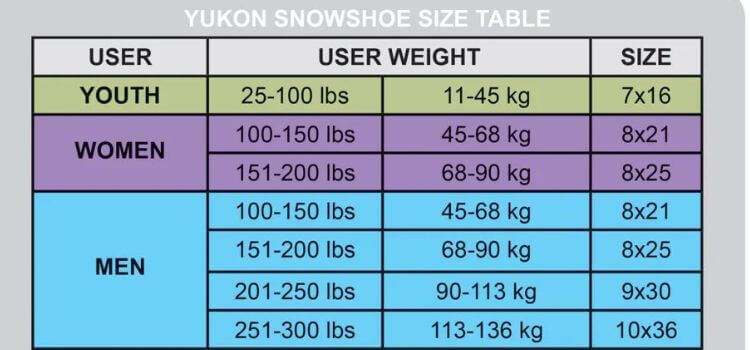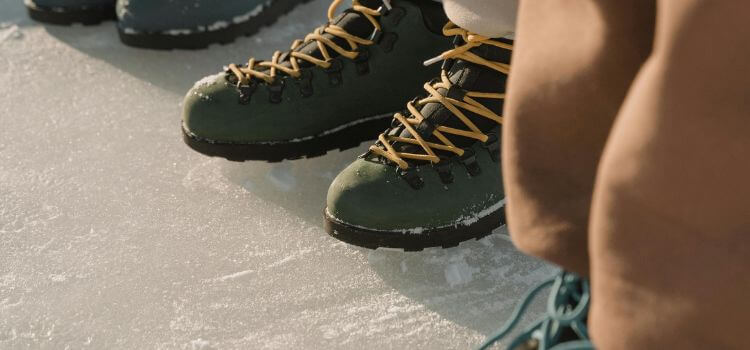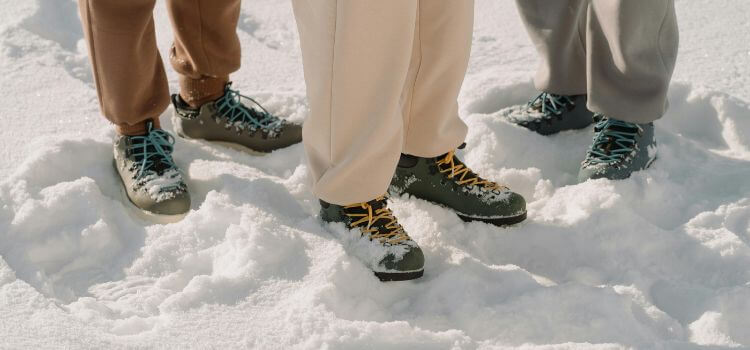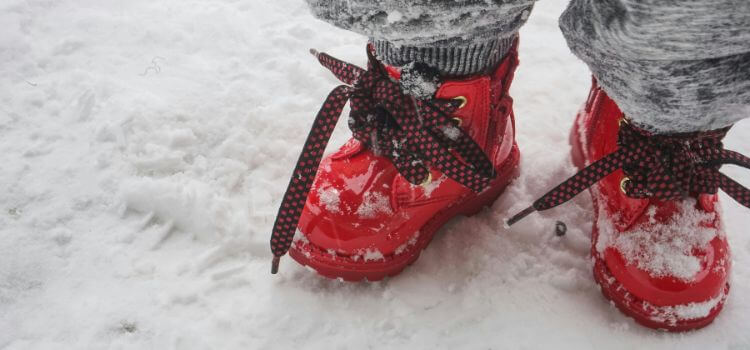As an Amazon Associate, I earn from qualifying purchases.
To size snowshoes correctly, consider your weight and the snow conditions. Choose a larger snowshoe for heavy loads or powdery snow.
Selecting the right snowshoes is crucial for your winter adventures. It’s a simple process that hinges on two main factors—your total weight (including gear) and the type of snow you’ll be trekking through. This balance ensures flotation and maneuverability. A perfectly sized snowshoe prevents you from sinking too deeply into the snow, conserving energy and increasing your enjoyment of the great outdoors.

Keep in mind that snowshoe sizing isn’t an exact science; it’s about finding the most practical fit for your needs. With advancements in design, snowshoes now come in a variety of shapes and sizes, catering to different activities, from backcountry expeditions to casual hikes on well-traveled trails. Remember to account for all variables to secure the optimal size for your snowy excursions.
The Importance Of Proper Snow Shoe Sizing
When winter blankets the ground with snow, snow shoes become essential for adventurous spirits. Sizing snow shoes correctly is crucial to ensure safety and enjoyment in the snow. A perfect fit ensures stability, efficiency, and comfort, allowing you to navigate snowy terrains with ease. Let’s explore the factors that determine the right size and the consequences of getting it wrong.
Factors That Influence Snow Shoe Size
Choosing the right snowshoe size isn’t just about your foot size. It also involves considering:
- Weight: Your body weight plus any gear you’ll be carrying.
- Terrain: Flat terrain needs different sizes compared to steep or uneven ground.
- Snow Conditions: Powder snow requires larger shoes for better flotation.
- Activity Type: Racing, hiking, or casual walking influence the size and design needed.
Consequences Of Improper Fit
An improper fit doesn’t just cause discomfort but can lead to issues:
- Reduced Balance: Too small and you’ll sink; too large and you’ll trip.
- Fatigue: An unfit size requires more energy, leading to quicker exhaustion.
- Blistering: Incorrect fitting leads to friction, causing uncomfortable blisters.
- Increased Risk of Injury: Poorly sized shoes can cause slips or falls.
Understanding Snow Shoe Design
Snowshoes enable you to walk across snow-covered ground without sinking. Their design distributes your weight evenly over a large area. This phenomenon, known as flotation, helps adventurers to hike, hunt, or enjoy the winter wonderland. Before deciding on the right pair of snow shoes, it’s crucial to understand their construction and how they function across different types of terrain.

Main Components Of Snow Shoes
Each snowshoe comprises several key elements. The frame is the foundation, typically shaped in an oval or teardrop. It gives structure and enables flotation. The decking, usually made from durable, lightweight synthetic materials, attaches to the frame and helps to distribute weight evenly. Bindings secure your boots to the snowshoes and pivot to allow for natural foot movement. Finally, crampons or cleats underfoot provide traction on icy or hard-packed snow.
- Frame: Provides structure and flotation
- Decking: Aids in weight distribution
- Bindings: Keep your boots attached and allow foot movement
- Crampons/Cleats: Offer traction on slippery surfaces
Variations For Different Terrains
Snowshoes are not one-size-fits-all. They vary based on the terrain you’ll tackle.
| Terrain Type | Snow Shoe Features |
| Flat | Simple designs with moderate flotation and fewer crampons |
| Rolling Hills | Increased flotation and more aggressive crampons for stability |
| Mountainous | Lightweight frames, high flotation, and strong bindings for varied slopes |
For gentle terrain, basic models suffice. More challenging conditions necessitate advanced features. Highly mountainous trails require snowshoes made of sturdy materials and enhanced traction. Those headed to rolling hills should look for a balance between weight and support. When traversing flat landscapes, comfort and moderate flotation are key.
Body Weight And Snow Shoe Size
Understanding the link between body weight and snowshoe size is essential for outdoor enthusiasts. The right size snowshoe provides needed floatation on the snow and keeps you from sinking deep into the powder. A key factor in selecting the correct size is your total weight, which includes both your body and your gear.
Calculating Load For Snow Shoe Selection
To choose the perfect snowshoe size, start by calculating your load. This load is your weight plus the weight of what you are carrying. We use a simple formula:
- Your weight
- +
- Gear weight
- =
- Total load
Select snow shoes based on this total load.
| User Weight | Snow Shoe Size Recommended |
| Up to 80 lbs | 16 – 19 inches |
| 80 – 160 lbs | 20 – 23 inches |
| 160 – 220 lbs | 24 – 27 inches |
| 220 kg and above | 27 inches and up |
Adjusting For Gear Weight
Outdoor trips often require carrying gear.
Weigh your gear before the trip.
Remember, extra gear means a larger snowshoe size is necessary.
- Day hiking might add 10-15 lbs.
- Overnight camping could add 20 lbs or more.
Ensure to factor in this extra weight for optimal snowshoe performance.
Snow Conditions And Their Impact On Size
Choosing the right size for snowshoes is critical for your outdoor adventure. It ensures comfort and safety. Snow conditions greatly affect the size of snowshoes you need. Selecting the correct size for specific snow types maximizes efficiency. It helps conserve energy. Let’s explore how to adjust for various snow conditions.

Size Adjustments For Powder Snow
Powder snow calls for larger snowshoes. They provide better flotation. This type of snow is light and fluffy. It lacks density. With larger snowshoes, weight spreads across a larger area. This prevents sinking too deeply. Consider the following:
- Go for longer and wider snowshoe models.
- Distribute weight evenly across the snow.
- Increase surface area to stay atop the powdery surface.
Hardpack And Icy Conditions
For hardpack or icy snow, traction is key. Smaller snowshoes work better. They allow for more agility. This snow type is compact. It’s often slick. A smaller footprint on the snowshoe helps with grip. It enables better maneuverability. Key points include:
- Choose snowshoes with metal teeth or crampons.
- Look for models that are narrower and shorter.
- Consider your weight to prevent over-penetration.
Personal Stride And Comfort Considerations
Choosing the right size snow shoes is crucial for a fun winter adventure. Your stride and comfort are key to finding the best fit. Snowshoes that match your walking style and fit well make all the difference.
Matching Snow Shoe Length To Stride
The length of your snowshoe should complement your natural stride. If you have a long stride, longer shoes will give you better floatation on snow. Shorter shoes are ideal for smaller steps. Here’s a guide to help you:
| User Weight (lbs) | Snow Shoe Length (inches) |
| Less than 120 | 20 – 22 |
| 120 – 200 | 25 – 30 |
| More than 200 | 30+ |
Width For Stability And Maneuverability
The width of your snow shoes impacts your stability and control. Narrow shoes are great for tight trails, offering better maneuverability. Wider shoes provide more stability in open spaces. Consider the type of terrain you’ll be exploring:
- Narrower Snow Shoes – Dense forests or narrow trails
- Wider Snow Shoes – Open fields or deep powder
Always try different sizes before buying. Ensure a comfortable fit for your winter escapades.
Trying On Snow Shoes: A Hands-on Approach
Knowing the right fit for your snow shoes ensures comfort and safety. Indoor and field tests are vital. Find the perfect pair with a hands-on approach. Let’s discover the process, starting indoors.
Indoor Fitting Tips
Begin at home or in a store. Follow these simple steps:
- Measure your footwear: Check that your winter boots fit the bindings.
- Adjust the straps: Ensure they secure tightly around your shoes.
- Walk around: Confirm no pinching or discomfort occurs.
- Check the weight limit: Snowshoes must support your weight plus gear.
Aim for a snug fit but with room for movement to prevent fatigue. Now, let’s take the fitting to the next level outdoors.
Field Testing For Final Verification
True testing happens in the snow. Perform these checks:
- Stomp and walk: Ensure stability and no shifting of the shoe.
- Ascend and descend: Your shoes should grip without sliding.
- Check for snow build-up: A good design prevents excess snow from sticking.
Pass this ultimate test, and you’ve found your ideal snow shoes. Get ready for adventure with confidence!
Special Considerations For Children And Small Adults
Getting the right size in snow shoes is essential for a safe and enjoyable winter adventure, especially for children and small adults. Fewer things bring more joy than a kid’s excitement on snowy trails, but it requires special attention to detail to ensure their gear is up to the task. Whether they’re stepping out into the backyard or setting off on a family expedition into the wilderness, young explorers need snow shoes that are not just safe and secure but also adaptable to their rapid growth.
Kid-friendly Snow Shoe Features
When selecting snow shoes for younger adventurers, consider features designed for their unique needs:
- Traction bars or crampons tailored for lighter weights ensure grip without overwhelming small feet.
- A rotating toe cord design will let the tail of the snowshoe drop, shedding snow and reducing fatigue.
- Bindings should be easy to use with gloves on, allowing for quick adjustments and a snug, comfortable fit.
- Opt for models with bright colors and patterns that are not only appealing but also improve visibility on the trails.
Size Adjustments For Growing Adventurers
Adaptability is key for snow shoes designed for children and small adults. Here’s how to choose gear that grows with them:
| Feature | Benefit |
| Adjustable Bindings | Accommodate growing feet or different boots. |
| Flexible Frames | Adjust to varying weights as kids grow. |
| Modular Tails | Add length to the snowshoe as the child’s stride lengthens. |
It’s beneficial to check the weight capacity of snow shoes and consider the weight of clothing and any backpacks your child might carry. Lightweight models with adjustable features offer the perfect balance between function and comfort for the little ones, ensuring many seasons of use.
Maintenance And Storage For Lasting Fit
The right care keeps snow shoes in top condition. Proper maintenance and storage are key. These steps ensure your snow shoes always fit well and last many seasons.
Preserving Your Snow Shoes’ Shape
Take care of your snow shoes like precious tools. They need regular cleaning to stay in shape. Follow these guidelines:
- Remove snow and ice after each use.
- Use a mild soap and water for cleaning the frames.
- Dry thoroughly before storage to prevent rust.
- Examine bindings for wear and tear. Repair if necessary.
- Keep the shape by storing them flat or hanging.
Seasonal Storage Tips
When winter ends, store your snow shoes right. Follow these tips for best storage:
- Choose a cool, dry place away from sunlight.
- Hang them or lay them flat, avoiding pressure on the bindings.
- Do not store them in a plastic bag. Breathable fabric bags work best.
- Check periodically for any mildew or pests.
Advanced Features For Custom Sizing
Choosing the right snowshoes can upgrade your winter hiking game. User-friendly advanced features help perfect the fit and adapt to different snow conditions. Let’s explore how these features can custom-size your snowshoes for a better experience.

The Role Of Bindings
Bindings play a crucial role in snowshoe sizing. They ensure your boot stays secure, even in deep snow. Look for bindings that adjust easily for a snug, comfortable fit.
- Ratchet straps – Quick to adjust and release.
- Pivot systems – Allow natural foot movement.
- Boa closure – Offers micro-adjustments with a dial.
Test different binding types. Choose one that simplifies customization and is glove-friendly.
Tail Extensions For Variable Conditions
Tail extensions make snowshoes adaptable to changing snow conditions. They add length to the shoe, which improves flotation in fresh powder.
- Easy to attach – Clips or pins secure extensions.
- Removable – Take off for firmer snow or to reduce weight.
- Versatile – Customize snowshoes for different adventures.
Consider the snow type and depth. Add or remove extensions accordingly. This flexibility helps tailor your snowshoes for optimal performance.
Where To Buy And Expert Fitting Services
Finding the right snow shoes is key to your winter adventures. Let’s look at where to buy them and how to get expert fitting services.
Local Outdoor Shops
Local outdoor shops are treasure troves of expertise and personalized service. Staff can measure your feet and suggest the best size based on your weight and shoe type. Here’s what to expect:
- Personal attention from experienced staff
- The diverse range of brands and designs
- Try before you buy: walk around in-store
- Guidance on proper fit and sizing
- Local return options for easy exchanges
Online Resources And Sizing Charts
Can’t make it to a store? Online shops offer convenience. They have sizing charts for accurate selection. Follow these steps for a perfect fit:
- Measure your shoe size and weight.
- Refer to the brand’s online sizing chart.
- Take into account the type of snow and activity.
- Customer reviews can guide your choice.
- Look for online shops with good return policies.
For the best results, compare your measurements to multiple charts. Choose a size that fits across different brands. Quality snow shoes support your adventures for many winters!
Frequently Asked Questions For How To Size Snow Shoes
To determine your snowshoe size:
1. Consider your weight and gear combined with the recommended load for the snowshoes.
2. Check the manufacturer’s size chart for precise sizing.
3. Choose larger snowshoes for softer snow or lighter ones for firmer conditions.
It’s generally better to size up in snowshoes for optimal floatation in deep snow. This ensures your weight is well-distributed, which reduces sinking.
To snowshoe effectively, you typically need at least six inches of snow to provide sufficient coverage and support.
To fit snowshoes into boots, first align the ball of your foot with the snowshoe hinge. Secure your toe in the front binding, and then tighten the heel strap snugly to prevent slipping, ensuring a firm yet comfortable fit.
Conclusion
Selecting the right snowshoes is vital for your winter adventures. Consider your weight, activity type, and snow conditions to ensure proper fit. Remember, the perfect pair enhances your hiking experience. Embrace the tranquility of snow-laden trails with confidence in your gear.
Happy snowshoeing!
Amazon and the Amazon logo are trademarks of Amazon.com, Inc, or its affiliates.